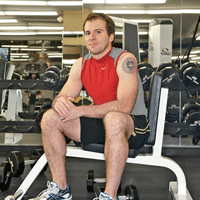Balance Running and Strength Training
Increase strength to burn more calories and prevent injuries.
By Leslie Goldman
Image by Michael Warren
From the April 2009 issue of Runner's World
Dieter's Strategy: Avoid strength training to keep from adding on pounds.
Runner's Strategy: Balance running and strength training.
Dieters often shy away from strength training, such as lifting weights, out of a fear it will make them bulk up. Others are intimidated by going to a gym. But for many dieters, the reason is simpler: They know one hour of intense cardio burns more calories than one hour of strength training. If you're pressed for time, it would seem that intense cardiovascular exercise would provide more bang for your buck, leading to a greater weight loss than pumping iron.
Yet the truth is that taking the time to add strength training to your routine a few days a week has a number of unintuitive benefits that can help boost your weight loss. Studies have shown that strength training can improve body composition by helping you maintain or increase your lean body mass and can decrease your percentage of body fat, helping you look leaner and burn additional calories. Here's how it works.
1. Muscle Burns More Calories: "Fat burns almost nothing at rest," says exercise physiologist Pete McCall, "whereas muscle uses oxygen. If you increase lean muscle mass, you'll increase the body's ability to use oxygen and burn more calories." Your body typically uses about 4.5 to seven calories per pound of muscle every day. If a 160-pound runner with 20 percent body fat increases his muscle mass and lowers his body fat to 15 percent, he'll burn an extra 36 to 56 calories a day at rest—simply by adding muscle.
2. You'll Be More Efficient: Strength training can help you run faster, longer, and more efficiently. A study published last year in the Journal of Strength and Conditioning Research showed that runners who add three days of resistance training exercises to their weekly program increase their leg strength and enhance their endurance. Obviously, runners with better endurance can run longer—and burn more calories. You'll also be able to recover faster from those long runs because strength training makes your body more efficient at converting metabolic waste into energy. "It's like being able to convert car exhaust into gas," says McCall.
3. You'll Be Less Injury-Prone: "If you increase your strength, you'll also increase your joint stability, reducing your risk of repetitive stress injuries," says McCall, citing a study in the Journal of Strength and Conditioning Research, which showed that incorporating moves such as squats, single-leg hops, and ab work into a workout can not only prevent lower-body injuries, but improve performance as well. Leg exercises are particularly important when it comes to reducing injury: These exercises strengthen muscles around the knees and hips—two areas that often cause problems for runners.
Real Runner: Tom Parnell 34, Boston
"In 2007, I was running about 25 to 30 miles a week—that is, until I tore my calf muscle playing flag football and was sidelined for nine months. I replaced running with couch surfing and junk food and, not surprisingly, put on 40 pounds in no time. When I started running again, my knees killed me from all the weight I had put on. So I added a three-days-on-one-day-off strength-training routine to my regimen, focusing on two muscle groups at a time. I believe that lifting weights helped me drop about half of the 40 pounds I eventually lost—plus I got stronger, faster, and have been able to avoid another injury."
Powerful Stuff
Ready to add strength training into your routine, but pressed for time? Exercise physiologist Pete McCall suggests adding the exercises here to your postrun routine. Start with one session per week and work up to three. Both use a number of muscle groups—plus, they're easy to do and take just a few minutes. "After 16 weeks, your pants size will shrink, you'll have more energy, and you'll be more powerful and efficient," he says.
Squat to Row
Strengthens knees, quads, glutes, hips, back, core, biceps
1. Stand two feet from a cable machine set at a weight that's hard but controllable.
2. Holding onto the cable handles with your arms extended, squat down.
3. As you return to standing, pull your hands toward your diaphragm, keeping elbows by your torso. Do two or three sets of 12 to 15 reps.
Wood Chop
Strengthens hips, quads, glutes, shoulders, back, core
1. Stand with feet shoulder-width apart, holding a five- to eight-pound medicine ball in your hands.
2. Squat down with the ball between your knees, keeping your heels on the floor, sticking your butt out, and not letting your knees go more than a few inches toward your toes.
3. Return to standing, raising the ball overhead, maintaining a slight bend in your knees. Keep your core engaged the whole time, as if bracing for a punch. Do two or three sets of 12 to 15 reps; increase weight of the medicine ball when you can do 15 in good form.
Hard Fact After age 30, inactive adults will lose three to five percent of their muscle mass per decade.













3 comments:
Great Post Mike !
That is a good article Mike
Do you do a lot of running while do the Beachbody programs
thanks for the comments!
Post a Comment